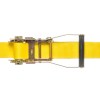
Battle of the Hybrids: 3 Advantages the Honda CR-V Hybrid Has Over the Ford Escape Hybrid
Fuel efficiency is one of the many reasons to buy a hybrid vehicle. Ford’s Escape and Honda’s CR-V are two of the most popular compact hybrid SUVs with good fuel economy ratings. While both models offer decent features, the CR-V appears to be the better value. Let’s look at how similar the two versions are and what three advantages the Honda has over the Ford.
How the Ford Escape and the Honda CR-V Hybrids were alike
Both compact SUVs have pretty good fuel economy ratings. With the Honda CR-V, you can get around 38 mpg overall with its all-wheel drivetrain. With the Ford, you get a little more with its 40 mpg combined rating on the comparable all-wheel drive version.
The pricing for both is pretty close. With the Honda, you can expect to pay around $32,000, while the Escape comes in at $30,000 to start. Warranties for each one are the same, with a 3-year/36,000-mile basic and a 5-year/60,000-mile powertrain warranty. So both are well-covered.
As for how safe each compact SUV is, you can expect the same from each one. According to Kelley Blue Book, both models received an IIHS Top Safety Pick award for their safety crash test performance. Both versions also received five stars in all areas from the NHTSA.
1. Honda CR-V’s interior space

Regarding interior space for a compact SUV, both offer decent measurements for the head and shoulder room. But, when it comes to legroom, especially in the rear seats, where it’s often cramped, the CR-V comes out on top. It offers 30.4 inches of space compared to the Escape’s 38.9 inches.
The CR-V also wins when it comes to cargo space as well. You’ll get 33.2 cubic feet of space behind the second row of seats and a whopping 68.7 cubic feet if you fold down the rear seats. The Ford Escape competes pretty well with 34.4 cubic feet behind the second row, but if you fold down the seats, you only get 60.8 cubic feet, which is quite a bit smaller than the CR-V.
2. Honda CR-V’s drivetrain
We know that an all-wheel drivetrain sends power to all four wheels of the car. This enables the vehicle to grip the road easier, providing traction on snow-covered or icy roads. It also helps some SUVs handle rougher terrain when drivers go on off-roading adventures. Consumers often lean toward vehicles with this feature despite the drop in fuel efficiency.
Ford’s Escape offers front-wheel drive as standard on all its trims. You can, however, add AWD to your purchase for extra money. The Honda CR-V Hybrid has all-wheel drive as standard equipment across all trim levels, making it a better value.
3. CR-V’s richer feeling interior
Both SUVs have relatively affordable prices, with the Escape offering more savings. However,
Ford’s compact SUV doesn’t offer a whole lot when it comes to the richness of the interior. It’s pretty simple and bland when compared to what the CR-V offers. With the Honda, you can expect pretty comfortable seats and high-quality materials.
Even the base trim of the CR-V has features usually seen on upper trims with other models. You get heated seats in the front, a moonroof, and a push-button start. Ford has a few good features with its infotainment system and Sync 3 application, but it isn’t on the same level as what Honda offers.
While Honda and Ford offer great compact hybrid SUVs, the CR-V edges out the Escape in three significant ways. One deals with its passenger and cargo space, another with the richness of its interior, and lastly, its standard all-wheel-drivetrain offering.


